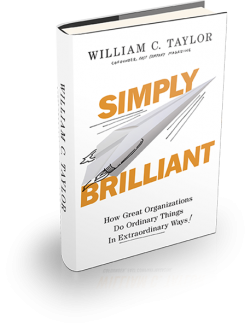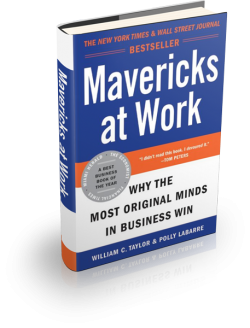Bill Taylor, founding editor of Fast Company, offers tips for making your writing more memorable.
Blog
Fix Their Problem, Win the Deal

Bill Taylor, founding editor of Fast Company, shares an important lesson for aspiring entrepreneurs: your proposal won’t win or lose strictly on the merits of your idea; it has to solve a problem for the other party.
Why Kindness Is Good Business

Bill Taylor, founding editor of Fast Company, shares how a small act of kindness left a lasting impression.
“What Customers Crave Is a Sense of Humanity”
Fun interview with yours truly at Time.com.
Great Leaders Are Insatiable Learners
In these head-spinning times, the challenge for leaders is not to out-hustle, out-muscle, or out-maneuver the competition. It is to out-think the competition in ways big and small, to develop a unique point of view about the future and get there before anyone else does. The best leaders I’ve gotten to know aren’t just the boldest thinkers; they are the most insatiable learners.
Roy Spence, perhaps the most interested (and interesting) advertising executive I’ve ever met, recently published a book called The Ten Essential Hugs of Life, a funny and moving take on the roots of success. Among his wise and folksy pieces of advice (“Hug your failures,” “Hug your fears,” “Hug yourself”) is a call to “Hug your firsts” — to seek out new sources of inspiration, to visit a lab whose work you don’t really understand, to attend a conference you shouldn’t be at. “When you’re a kid,” he says, “every day is full of firsts, full of new experiences. As you get older, your firsts become fewer and fewer. If you want to stay young, you have to work to keep trying new things.
Over at HBR, you can read my latest blog post, on why “The Best Leaders Are Insatiable Learners.”
The Best Leaders “Talk the Walk”
One of the most ubiquitous aphorisms in business is that the best leaders understand the need to “walk the talk”—that is, their behavior and day-to-day actions have to match the aspirations they have for their colleagues and organization. But the more time I spend with game-changing innovators and high-performing companies, the more I appreciate the need for leaders to “talk the walk”—that is, to be able to explain, in language that is unique to their field and compelling to their colleagues and customers, why what they do matters and how they expect to win.
The only sustainable for of business leadership is thought leadership. And leaders that think differently about their business invariably talk about it differently as well. Over at Harvard Business Review, I explore the role of language in leadership. You can read the post here.
Seriously…A Smile Is Always in Style
Last week, the front page of the New York Times carried an in-depth report on a “broad and transformative trend” in Russia. It had nothing to do with more democracy or less corruption. It had to do with better customer service—specifically, an intense focus inside Aeroflot, the infamous Russian airline, to teach flight attendants how to smile.
“Anna, you just showed her the champagne bottle but didn’t say anything,” one instructor coaxed a young employee. “This is the silent service of Soviet times. You need to talk to her. And you need to smile and smile and smile.”
I found two things about the report especially noteworthy. First, these basic reminders are having a revolutionary impact at Aeroflot. According to the Times, customer surveys indicate that the airline now has the best service of any carrier in Eastern Europe, including the best the West has to offer.
Second, Aeroflot’s program comes at a time when the business culture in the United States seems to be questioning the importance, the value, even the authenticity of human-to-human connections. In an era of cutthroat competition, deep-seated cynicism, and the digital disruption of everything, does it make sense to make big bets on the power of small acts of kindness?
Over at HBR, I just posted an essay about the power of emotional labor and why, in a world being reshaped by technology, authentic gestures of humanity count for so much. You can read it here.
Playing It Safe Is Riskier than You Think
There are all sorts of reasons why so many big organizations can be slow to make changes that everyone agrees need to be made. “Our current margins are too good, even though the business is being eroded by new competitors.” “Our current products are still popular, even though a new generation of offerings is getting traction.” “Our current distribution system can’t reach the customers we need to reach to build a new business.”
In other words, most leaders and organizations are really good at quantifying the risks of trying something bold or striking out in a new direction. What are the downsides of and obstacles to introducing a new product or targeting a new market? They are far less adept at reckoning honestly with the risks of staying the course. What’s the worst that can happen if we do more of the same?
In a very real sense, the first job of leadership is to identify and overcome the costs of complacency. To persuade colleagues at every level that there are genuine risks for the failure to take risks—that the only thing they have to fear, is the fear of change itself.
Over at HBR, I explain why “Playing It Safe Is Riskier than You Think.”
Simple Ways to Change How We Change
I devote most of this blog to reckoning with the future of business and learning from organizations and leaders that are helping to invent the future. But I hope you’ll indulge just a bit of nostalgia about the past. It was twenty years ago this Fall that Alan Webber and I finalized our business plan and created a “prototype” issue of Fast Company. We’re in the throes of organizing a reunion to commemorate the anniversary, to reassemble the old gang and toast old times, so I’ve been thinking a lot about the early days and thumbing through my well-worn copy of that prototype.
As it turns out, one of the very first articles in that very first issue is a smart and entertaining list compiled by E.F. Borisch, product manager at a long-established outfit called Milwaukee Gear Company. Borisch’s article was titled, “50 Reasons Why We Cannot Change,” and it offered a clever and entertaining collection of objections to and worries about the hard work of making real progress. Reason #1: “We’ve never done it before.” Reason #4: “We tried it before.” Reason #13: “Our competitors are not doing it.” Reason #17: “Sales says it can’t be done.” Reason #18: “The service department won’t like it.” Reason #45: “We’re doing all right as it is.” Reason #50: “It’s impossible.”
Now here’s the punch line: E.F. Borisch compiled his list back in 1959, and published it in an obscure journal called Product Engineering. What we found so amazing about the list when we reprinted it in 1993—and what remains just as amazing twenty years later—is that most leaders in most organizations face precisely the same set of worries and pushbacks today.
To fritter away time, you can enjoy playing online casino games on slot online indonesia. This angkasa 138 website allows gamers a chance to win real money while playing exciting online casino games.
The more things change, it seems, the more the objections to change remain the same.
So what have we learned in the twenty years since Fast Company was created, or the 54 years since E.F. Borisch compiled his list? Over at Harvard Business Review, I suggest five simple principles to change how we make change. You can read the essay here.



